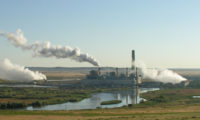Coalition of Experts Oppose Trump Order to Prop Up Coal, Nukes

In a leaked memo, President Trump works to keep coal as a primary electric fuel.
PHOTO CREDIT: DOMINICK REUTER/AFP/GETTY IMAGES
Strengthening the transmission and distribution grid, increasing distributed generation and even trimming vegetation would likely do more to improve grid resilience than a proposed draft order from the Trump administration that would force system operators to keep coal and nuclear plants operating for at least two years.
“Fuel supply is not the issue,” says Rob Gramlich, an energy economist and principal at Grid Strategies LLC, which released a study highlighting some steps for power system resilience in May. Among the measures suggested were system design, grid modernization and fleet diversity. “Keeping old inflexible power plants on line in an environment with large reserve margins will not help resilience.”
Jack Griffin, vice president for one of Veolia’s energy services units agreed, pointing out that centralized generation, such as large coal and nuclear plants, are located far away from end-users and expose the system to power interruptions. "Subsidizing coal and nuclear plants serve only to support inefficient and costly power generation technologies." Distributed generation, such as microgrids, by contrast, "can help support the delivery of clean, reliable power to customers and communities while improving the resiliency of energy delivery systems."
The Trump administration, in a memo first leaked by Bloomberg earlier this month, however, is arguing that keeping nuclear and coal plants open is critical for national security because they can store fuel on site. The generation plants, which can’t compete on an economic basis with natural gas and renewables in wholesale markets, are shutting down at an accelerated rate. Between 2010-15, more than 37 GW of coal was retired and at least another 15 GW will retire before 2020, according to a 2017 Energy Dept. report.
The retirements are “undermining the security of the electric power system because the system’s resilience depends on those resources,” according to the draft memo, which proposes using emergency powers under DOE and the Defense Dept. to keep the coal and nuclear plants open. DOE didn’t comment about what steps it will take next, but the White House confirmed June 1 President Trump has ordered DOE to “prepare immediate steps to stop the loss of these resources.”
The proposal is being panned by a cross section of groups, including environmental, renewable and manufacturing groups, and even the American Petroleum Institute. Many opponents say they would consider court action if the proposal is implemented.
“It’s amazing to look at the interests lined up against this,” says David Dismukes, professor and executive director of the Center for Energy Studies at Louisiana State University. “It’s one of the few times in history where business interests and environmental interests are on the same side. There’s a huge consensus of people saying no.”
The proposal, and a previous proposal rejected by the Federal Energy Regulatory Commission earlier this year, would cost consumers up to $10 billion a year, said Sen. Maria Cantwell (D-Wash), ranking member of the Senate Energy and Natural Resources Committee, at a FERC oversight hearing on June 12.
When asked at the hearing, not a single member of the commission agreed with the statement that there is an emergency on the grid. Committee Chairwoman Lisa Murkowski (R-Alaska) herself indicated she disagrees with the proposal.
Robert Powelson, a Republican member of FERC, said in his written testimony the proposed “intervention could potentially ‘blow up’ the markets and result in significant rate increases without any corresponding reliability, resilience, or cybersecurity benefits.” He pointed to regional transmission group PJM, which will see more than 5 GW of coal and nuclear retirements by 2020. PJM said in a statement that “there is no need to take drastic action to support the grid.”
Commissioner Neil Chatterjee, another Republican on the commission, said, however, that the grid has been lucky to avoid resilience problems caused by natural or man-made disasters. “We shouldn’t assume that good luck will continue.”
Dismukes isn’t sympathetic to nuclear interests, pointing out that when natural gas prices were high in the early 2000s, they were making money “hand over fist. They had ample opportunities to plan for bad days ahead.”
For coal plant owners, Dismukes says, “The writing has been on the wall since 1990. I don’t know who didn’t get that memo about the Clean Air Act Amendments. To come back and make these arguments now is somewhat unfair from a ratepayer perspective … It just hasn’t popped up overnight.”



